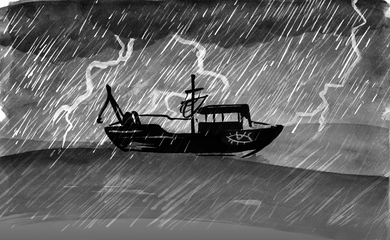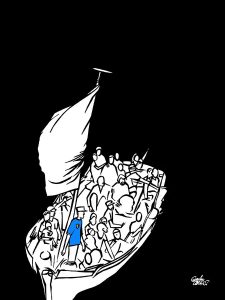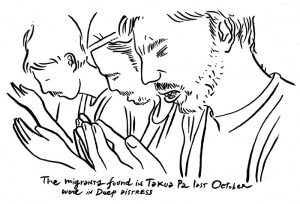Migration has been tackled multiple times by the pioneers of modern graphic journalism. Malta-born, Melbourne-bred American author Joe Sacco treated the issue in relation to his native island. “Not in my country” – published by The Guardian – is a tale of unwanted immigrants in the Mediterranean. Here the political element is filtered by deep human empathy.
“There are very few people who do graphic journalism the way Sacco does, going on the field, making cross-interviews,” explains graphic journalist Gianluca Costantini. “What developed has been rather a sensitivity of a generation of comic book artists towards certain themes. Many of them don’t do exclusively graphic journalism. They are artists who choose this medium to tackle timely issues, but they also pursue other art forms.”
For Costantini it’s just natural stories of migration are more and more frequent in graphic journalism, as this is a time when we need to understand the individuals behind the numbers. “I don’t think there is a peculiar affinity between comic books and the theme of migration, but it’s rather people and magazines requesting those kind of stories. Maybe someone tackled migration before it made the headlines, but it’s just now that their work would emerge.”
Inevitably, as Costantini explains, graphic journalism is different from traditional journalism: “The image is a filter. Willing or not, the presence of the comic book artist will always be prevalent in a graphic journalism piece compared to the one of a simple reporter.” A comic book plays different strengths compared to a magazine essay. “Of course, in comics you can easily start telling the history of Palestine with dates and everything, just know no one is going to read it”. That doesn’t make graphic journalism less accurate. “It’s just different. In a graphic novel or a vignette drawing and text interact with each other. You don’t need to spend pages and pages to describe a landscape, you just draw it.”
Costantini also points out that satirical vignettes who have always been there since the inception of newspapers, are a completely different animal from graphic journalism – especially the kind Costantini is pursuing. Whereas one is satire, the other is a text-based image which neither aspire to a laugh, nor to be servile to an event. “It is a thing that can come alive when it’s used by people.” Indeed for their synthetic and striking quality, Costantini’s vignettes have been adopted by political movements all over the world, printed and shared on the internet.
The internet is a fundamental component of Costantini’s way of drawing. “When I hear about, say, a protest somewhere in the world, I start drawing it, also to get to know it. I use exclusively Twitter. With my drawings I get in touch with the people protesting on the street and they might choose to adopt one of my drawings as a symbol. If they start sharing it, printing it as a poster or whatever, I’ll keep on exploring the issue and posting the resulting drawings on twitter. And it will grow from there.”
Through the interaction factor allowed by the web, innovative possibilities are created for the graphic journalism. This triangle internet, comics and migration finds a high expression in the interactive graphic novel “The Boat”, by Nam Le and Matt Huynh, published on Australia’s news channel SBS. This project – which has received a huge success – tackles Vietnamese migration in Australia.
“It’s a modern, canonical story that is a foundational narrative for the Vietnamese Australian, and indeed global Vietnamese diaspora,” explains The Boat producer Kylie Boltin. “The Boat is an engaging, innovative and creative execution of a specific refugee story. I am proud that a project we created leads to rigorous discussion and reflection and has such a string resonance and relevance to today.”
The final edit of the story – complete with music and animation – took Nam’s original story and created a twenty minute interactive experience. In terms of how the comic was rendered, SBS pushed the boundaries of what has been seen so far. “We did quite a bit of research and found that what we were doing was actually different to what was already out there.” Said Boltin, “In many ways, it was new terrain, which is a challenge but also an exciting space to inhabit.”
For artist Matt Huynh, working in a journalistic environment has helped strengthen accuracy and adapt to the new unconventional medium.
Migration is a recurrent theme in Huynh’s graphic novels. In CAB, he looked at stories from Cabramatta, a migrant community where he was raised. In this work he represented a sense of settlement and community building. In another graphic novel called MA, he connected to his parents, who came to live in Australia from Vietnam as refugees. He told their story as a young married couple.
While working on The Boat, it was impossible for Huynh not to consider my family’s story. “There were very close details to my own family’s journey. At the same time it was important to me to allow space in the story to feel easily connected to today’s refugees and contexts – wherever they originate from.”
For Huynh, representation of migrant stories is particularly important in a time of misinformation. A time where the discourse is happening with an imbalance of voices. “When the migrants, refugees, asylum seekers – and the supposed threat they pose to Australia and a current way of life – are broadcast to us by big media and by politicians, there is a great imbalance to the perception the public receives of these most vulnerable of people. People who may not have the best English, access to opportunities to tell their stories and to be heard.”
“As someone in a position to access these opportunities to tell these stories and who knows his way around a paintbrush a little bit,” says Huynh “it’s a responsibility and honour to show another dimension and give another voice to a story that I know well from my own personal history. That of my family, my friends and loved ones.”
Huynh has no doubt on what the leadership role of the artist ought to be: “To be fearless in our unrepentant, unashamed, honest representation of ourselves against other pressures, whether it be ideas of taste, commercial and financial pressures, approval or recognition.”
The artist believes that the greatest contribution people can hope for is to shine a light on themselves and their stories when others will not have the courage to or are being signaled to keep quiet and play nice. “We have to tell our stories or they’ll be told for us.”
Gianluca Costantini: http://www.gianlucacostantini.com/
The Boat: http://www.sbs.com.au/theboat/
Matt Huyhn: http://www.matthuynh.com/





